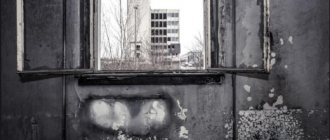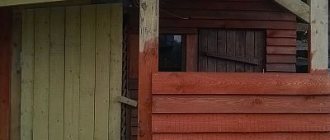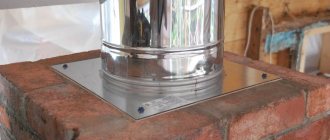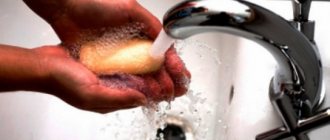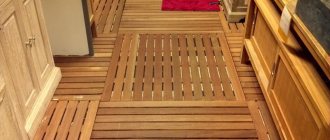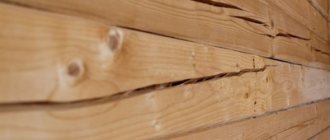Main recommendations
An important rule is to never use water or abrasive devices to clean wood walls. Immediately exclude such aids as:
- bleach or other chlorine-containing preparations;
- water;
- abrasive sponges;
- metal brushes;
- liquid soap;
- cleaning powders;
- sprayers;
- Karchers and steam cleaners.
Cleaning soot from the ceiling in a bathhouse Source alfaclean.by
Using a mechanical method to clean soot and deposits in a bathhouse Source remontnik.ru
When cleaning a bathhouse, be sure to follow safety rules and wear items of clothing that make contact with chemicals safe. These items include:
- working headdress (cap, headscarf, scarf);
- latex gloves;
- plastic buckets, basins (metal may oxidize);
- petal respirator (a four-layer gauze bandage is also suitable);
- robe;
- protective glasses.
When using special cleaning products for wood, be sure to read the instructions. Otherwise, you may harm the wood partitions.
Petal brush for cleaning wooden walls in a bathhouse Source ecosrub.ru
Removing soot from smooth washable surfaces
It is easiest to wash away burnt deposits from smooth interior items, for example, from plastic on a kitchen set or from furniture that has been varnished. Such surfaces have a non-porous structure, so it is difficult for contaminants to attach to them. In such situations, soot can be washed off using the following means:
- hard soap;
- dish cleaner;
- any washing powder.
To carry out a hygienic procedure at home, you need to dilute one of the listed products in warm water. Then take a soft sponge and wash off the black deposits with gentle circular movements. Periodically you will need to change the fluid to a new one to avoid the accumulation of contaminants.
Causes of soot and soot
Smoke with soot appears due to the low combustion temperature in the furnace or an improperly organized traction system. In such cases, when the boiler door is opened, clouds of smoke will come out and be absorbed by the walls. There are a number of other reasons why soot accumulates:
- The chimney pipe becomes overgrown with soot or a foreign object gets inside, making it difficult to remove the soot.
- Errors in the construction of heating equipment. Incorrect slopes, incorrect location of the smoke exhaust duct and the design of the stove itself can cause soot to appear. Only a thorough modification of the sauna heating will correct the situation.
- Strong wind. If the weather is bad outside, the wind can blow into the chimney. This will cause smoke to escape in the opposite direction. In this case, soot on the walls is inevitable. Some designs include a ridge, but often if the wind direction is unfavorable, it is absolutely useless.
- The appearance of cracks in brickwork. New holes begin to draw air out of the oven from all sides. This causes smoke to escape from the firebox. Even if you manage to ventilate the room, soot will still fall on the surface of the wooden walls.
- Smoke. If, after a long break, the firebox is not preheated, then smoke penetration into the room is inevitable. To prevent this, before starting the kindling, throw a few newspapers or a rag doused with gasoline inside, then set it on fire.
Single-story baths are a common practice; accordingly, the smoke exhaust system will be located lower. Therefore, bad weather and other factors that prevent normal air circulation inside the stove will cause smoke inside the room.
Cleaning walls in a bathhouse with ammonia diluted with water Source dizainvfoto.ru
Cleaning methods
Soot is very difficult to remove from wooden surfaces. For this purpose, two methods are used: mechanical and chemical.
Mechanical
All you need to do is dry the bathhouse thoroughly, ventilate it and make sure the walls are completely dry. All you have to do is be patient and use a stiff brush (not a broom, but the one you use to clean carpets, for example). Put on personal protective equipment and start cleaning.
Treatment of wooden surfaces in the bath after cleaning Source pk777.ru
How to clean burning plastic windows
Cleaning plastic windows is carried out in several stages.
First of all, carry out dry processing and remove traces of soot with a broom or vacuum cleaner.
Next, start cleaning the glass. Use available and purchased substances suitable for such purposes, for example, a vinegar solution or store-bought window cleaning spray.
At the last stage of cleaning, move on to the plastic parts. They can also be cleaned using window cleaning liquid or a solution based on available products, such as soda or alcohol.
Preparatory work before cleaning
Regardless of which method you want to use to remove soot from a bathhouse, you must first prepare.
- Clear the room of unnecessary items (towels, soap, various hygiene products).
- Wear protective clothing: be sure to wear gloves, a respirator, and goggles (choose special plastic ones with good transparency).
- Cover clean surfaces with polyethylene or any film to prevent dust and dirt from getting into these places.
- Take a broom and a hard-bristled brush and clean the top layer of dirt. Also remove all cobwebs and small debris from the coverings.
- After completing the steps, you can proceed to the main type of processing: mechanical or chemical method.
Elastic melamine sponge for removing soot from wooden walls in a bathhouse Source khoz-byt.rf
We suggest studying the list of expected materials and tools that will be required for the mechanical removal method:
- a long-handled brush-brush is suitable for removing dirt from crevices and corners;
- a sharp knife or knitting needles will help remove soot in hard-to-reach places: between logs, behind the stove;
- sandpaper with a fine degree of abrasiveness (it will help to carefully remove too fine dry soot without damaging the wood);
- A melamine sponge is suitable if there are small and non-permanent stains on the walls. This device acts like an eraser.
Please note that you can use folk remedies to clean soot from wooden walls. For example, crushed red brick. Its crumbs are rubbed onto walls in areas of contamination. This promotes removal. The spray can be applied to a dry cloth or sponge.
Brick chips for cleaning walls from soot in a bathhouse Source tennisitpro.rf
Household chemicals
In order not to complicate the work of cleaning the bathhouse, you can stock up on special products for removing soot and soot:
- BZ-20. A good lye based cleaner. Suitable not only for removing dry soot, but also smoky, greasy marks. Thus, except in the bath, the product can be used to remove greasy deposits in the kitchen.
- Pure Deso. This solution is usually used for final cleaning. That is, after removing the bulk of the contaminants. It is compatible with any composition and does not damage the wood surface.
- Facade cleaner No. 2. An interesting multifunctional solution that helps remove soot and neutralize harmful substances. It has a disinfecting effect on walls and helps get rid of fungus and mold.
- Mazbit+. Specially designed for removing traces of fire and smoke from wooden surfaces. It acts gently, does not damage the structure of the walls, its consistency remains imperceptibly on the coating and prevents the penetration of contaminants into small pores and crevices.
It is advisable to use these chemicals one at a time. Because mixing of odors may occur. This is very dangerous for your respiratory system. If you accidentally inhale the vapors, acute poisoning is possible.
Disinfecting walls in a bathhouse after cleaning from soot Source banyabest.ru
On a note! Before using any chemical composition, be sure to read the instructions for use.
Application of vinegar essence
It is necessary to dilute the product with water in a ratio of 1: 2, then thoroughly mix the two components, then apply the prepared product to the soft side of the sponge. Afterwards, all that remains is to wipe the contaminated surfaces with the composition until streaks appear, then rinse the sponge and reapply the diluted essence. This should be done until the soot completely disappears from the surface. Then you need to wipe it with a damp cloth.
On a note! If the soot layer is thick enough, then the vinegar is not diluted, but used in its pure form.
Final disinfection
Humidity, which is constantly present in bath rooms, leads to the development of mold or mildew. Therefore, even after cleaning the surface from soot, carbon deposits and soot, it is necessary to carry out disinfection. Antiseptics diluted in water are suitable for this: Domestos gel, ethyl alcohol, potassium permanganate, a solution of salt and copper sulfate dissolved in water in a ratio of 18 g, 44 g per 1 liter of water, respectively.
Then, after cleaning and disinfection, you can apply preventative agents to the surface that will repel dirt and prevent it from eating deep into the wood structure. This manipulation allows you to maintain the appearance and neatness of the steam room.
Important! Never use soapy water or sponges. By wiping the surface, all the particles will penetrate into the wood, making it impossible to remove dirt. The only option in this case is to remove the layer of wood along with the contamination. But this is not a reliable practice, since after this the soot will accumulate even more actively.
How to clean soot after a fire?
The first thing to do is to sweep the soot with a dry, stiff brush onto the oilcloth or newspaper. After this, you should use a sponge soaked in a special chemical composition. You can buy it at a hardware store. Use this sponge to thoroughly clean the surface. The next stage is wet cleaning with detergents that can dissolve grease. Perfect for washing dishes or toilet bowls. Please note: under no circumstances should you rub the product that you apply to the contaminated surface! Rinse it off with sharp movements so as not to smear the burnt residue.
Prevention of soot and soot in the steam room
The most important condition for maintaining cleanliness in the bathhouse is maintaining the proper operation of the traction system. To do this, the following list of measures is taken:
- sealing cracks in a brick kiln immediately after they appear.
- internal cleaning of chimneys from layers of soot.
- firebox with chimney-sweep logs: aspen firewood, potato peelings.
- Regular removal of ash from the ash pit.
- cleaning all surfaces in a bath with soda solution several times a year.
Brick
How to remove soot from a brick stove in a bathhouse? One of the most effective methods is to use a simple detergent and sponge. You need to take the detergent, dilute it with water and whisk until a thick foam forms. The treated surface should be left for 10-15 minutes, then rinsed with water. Another great way is to use vinegar essence. You will need tap water and table vinegar. For one glass of vinegar you need to take two glasses of water. Don't forget to use gloves! Apply the solution to the brick, leave for 10 minutes, then rinse thoroughly. How to wash off soot if it has penetrated deep enough into the brick pores? Vinegar can not be diluted with water, but simply applied to the masonry. Once the cleaning procedure is completed, use a soft brush and rinse the oven with clean water.
